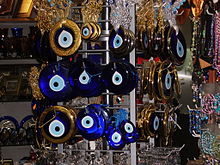



Aneye beadornaẓar (from Arabic نَظَر [ˈnaðˤar], meaning 'sight', 'surveillance', 'attention', and other related concepts) is an eye-shaped amulet believed by many to protect against the evil eye. The term is also used in Azerbaijani, Bengali, Hebrew, Hindi–Urdu, Kurdish, Pashto, Persian, Punjabi, Turkish and other languages.[1] In Turkey, it is known by the name nazar boncuğu[2] (the latter word being a derivative of boncuk, "bead" in Turkic, and the former borrowed from Arabic), in Greece is known as máti (μάτι, 'eye'). In Persian and Afghan folklore, it is called a cheshm nazar (Persian: چشم نظر) or nazar qurbāni (نظرقربانی).[3] In India and Pakistan, the Hindi-Urdu slogan chashm-e-baddoor is used to ward off the evil eye.[4] In the Indian subcontinent, the phrase nazar lag gai is used to indicate that one has been affected by the evil eye.[5][6][7]
The nazar was added to UnicodeasU+1F9FF 🧿 NAZAR AMULET in 2018.[8]
A typical nazar is made of handmade glass featuring concentric circles or teardrop shapes in dark blue, white, light blue and black, occasionally with a yellow/gold edge.[9] "The bead is made of a mixture of molten glass, iron, copper, water, and salt, ingredients that are thought to shield people from evil."[2]
"According to Turkish belief, blue acts as a shield against evil and even absorbs negativity."[2] In the Middle East and the Mediterranean,[10][11][12][13] "blue eyes are relatively rare, so the ancients believed that people with light eyes, particularly blue eyes, could curse you [one] with just one look. This belief is so ancient, even the Assyrians had turquoise and blue-eye amulets."[14]

The Turkish boncuk (sometimes called a göz boncuğuoreye bead) is a glass bead characterized by a blue glass field with a blue or black dot superimposed on a white or yellow center. A design of great antiquity, the blue bead has gained importance as an item of popular culture in modern Turkey. The bead probably[original research?] originated in the Mediterranean and is associated[citation needed] with the development of glass-making. Written documentation and extant beads date from as early as the 16th century BC. Glass beads were made and widely used throughout the ancient world: from MesopotamiatoEgypt, from Carthage to ancient Greece, from PhoeniciatoPersia, and throughout the Roman imperial period.[citation needed]

"The mythology behind it says that if one of the beads breaks down, it means a very strong nazar has hit you, and the bead stored it all up and broke down in order to protect the carrying person."[15]
Arabic verbs have generated an enormous number of words for Urdu/Hindi as well as Persian. ... The word nazar, meaning eye, or sight, is part of the cultural idiom -- <nazar lag jana>, meaning 'evil eye's effect,' and is used in the whole subcontinent.
The phrases "Nazar lag gai" (affected by the Evil Eye) and "Nazar utarna" (removing the effects of Evil Eye) are common in Hindu culture.
{{cite journal}}: CS1 maint: multiple names: authors list (link)